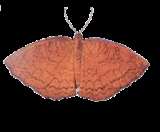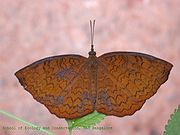
Ariadne merione
Encyclopedia
Ariadne merione, also known as the Common Castor, is an orange butterfly
with brown lines whose larva
e feed almost exclusively on Castor Ricinus communis. It is similar in appearance to Ariadne ariadne
, the Angled Castor.
This species is found in south-eastern Asia
. Their wingspan ranges between 30–35mm. Like others in the Nymphalidae family, their front two legs are small and unused, effectively making them four-legged. These smaller appendages are covered with long hairs, giving them the characteristic brush look.
 Male: Upper side brownish ochraceous. Fore and hind wings crossed by slender, somewhat obscure, very sinuous or zigzag dark basal, two subbasal and two discal lines disposed in pairs, followed by a single, sometimes double, postdiscal and a single subterminal slender line. All these lines more or less interrupted anteriorly on the hind wing, which has a smooth unmarked uniform appearance from costa to subcostal vein and vein 5. On the fore wing there is in addition a series of obscure spots between the postdiscal and subterminal markings, arid a small white subcostal spot before the apex.
Male: Upper side brownish ochraceous. Fore and hind wings crossed by slender, somewhat obscure, very sinuous or zigzag dark basal, two subbasal and two discal lines disposed in pairs, followed by a single, sometimes double, postdiscal and a single subterminal slender line. All these lines more or less interrupted anteriorly on the hind wing, which has a smooth unmarked uniform appearance from costa to subcostal vein and vein 5. On the fore wing there is in addition a series of obscure spots between the postdiscal and subterminal markings, arid a small white subcostal spot before the apex.
 Underside much as in Ariadne ariadne
Underside much as in Ariadne ariadne
, but the transverse chestnut bands broader, more diffuse. Antennae, head, thorax and abdomen brownish ochraceous. Sex-mark on the underside of the fore wing as in A. ariadne no sex-mark on upper side of hind wing;
Female: Similar; but on the upperside the transverse lines broader, more diffuse, with a greater tendency to form bands; the postdiscal line always double, forming a band traversed by a series of dark ochraceous spots in the interspaces; these lines and bands continuous, not interrupted anteriorly on the hind wing as they are in the male. Underside: except for the sex-mark, as in the male.
_in_kolkata_w_img_4467.jpg)
_in_kolkata_w_img_4465.jpg) Upperside : ground-colour much paler, the transverse lines more distinctly in pairs, forming bands, the ground-colour between each pair more dusky brown. Underside similar to that in the wet-season form, but the ground-colour paler, the bands more diffuse.
Upperside : ground-colour much paler, the transverse lines more distinctly in pairs, forming bands, the ground-colour between each pair more dusky brown. Underside similar to that in the wet-season form, but the ground-colour paler, the bands more diffuse.
Expanse: 52–62 mm
s of the genus are protected from predators by their long spinous bristles. Their chrysalids are pale green and angular in shape.
Butterfly
A butterfly is a mainly day-flying insect of the order Lepidoptera, which includes the butterflies and moths. Like other holometabolous insects, the butterfly's life cycle consists of four parts: egg, larva, pupa and adult. Most species are diurnal. Butterflies have large, often brightly coloured...
with brown lines whose larva
Larva
A larva is a distinct juvenile form many animals undergo before metamorphosis into adults. Animals with indirect development such as insects, amphibians, or cnidarians typically have a larval phase of their life cycle...
e feed almost exclusively on Castor Ricinus communis. It is similar in appearance to Ariadne ariadne
Ariadne ariadne
Ariadne ariadne, also known as the Angled Castor, is a species of nymphalid butterfly found in Asia.-Description:Males and females have fore wing truncate at apex; termen angulated at interspace 5, and again at apex of vein 3, concave between; tornus obtusely angulate. Hind wing: termen more or...
, the Angled Castor.
This species is found in south-eastern Asia
Asia
Asia is the world's largest and most populous continent, located primarily in the eastern and northern hemispheres. It covers 8.7% of the Earth's total surface area and with approximately 3.879 billion people, it hosts 60% of the world's current human population...
. Their wingspan ranges between 30–35mm. Like others in the Nymphalidae family, their front two legs are small and unused, effectively making them four-legged. These smaller appendages are covered with long hairs, giving them the characteristic brush look.
Wet-season form


Ariadne ariadne
Ariadne ariadne, also known as the Angled Castor, is a species of nymphalid butterfly found in Asia.-Description:Males and females have fore wing truncate at apex; termen angulated at interspace 5, and again at apex of vein 3, concave between; tornus obtusely angulate. Hind wing: termen more or...
, but the transverse chestnut bands broader, more diffuse. Antennae, head, thorax and abdomen brownish ochraceous. Sex-mark on the underside of the fore wing as in A. ariadne no sex-mark on upper side of hind wing;
Female: Similar; but on the upperside the transverse lines broader, more diffuse, with a greater tendency to form bands; the postdiscal line always double, forming a band traversed by a series of dark ochraceous spots in the interspaces; these lines and bands continuous, not interrupted anteriorly on the hind wing as they are in the male. Underside: except for the sex-mark, as in the male.
Dry-season form
_in_kolkata_w_img_4467.jpg)
_in_kolkata_w_img_4465.jpg)
Expanse: 52–62 mm
Distribution
All over India, Simla to Sikhim in the Himalayas, and recorded from Rajputana and Bengal; Assam; Burma; Tenasserim; Malayan Subregion. The Tenasserim specimens are darker and often without the white subcostal spot in the fore wing, approximating thus to the Southern Indian and Ceylon race.Larva
"Cylindrical, slender; segments armed with two dorsal and two lateral rows of short branched-spines; Arianna Perricone has a head with a pair of long, straight branched-spines. Colour green with dorsal longitudinal dark brown lines." (Moore) CaterpillarCaterpillar
Caterpillars are the larval form of members of the order Lepidoptera . They are mostly herbivorous in food habit, although some species are insectivorous. Caterpillars are voracious feeders and many of them are considered to be pests in agriculture...
s of the genus are protected from predators by their long spinous bristles. Their chrysalids are pale green and angular in shape.

